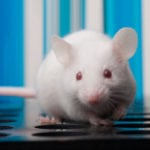 Weird Stuff
Weird Stuff  Weird Stuff
Weird Stuff  Mysteries
Mysteries 10 Tragic Disappearances and Deaths in Joshua Tree National Park
 History
History 10 Ways Childhood Really Sucked in the Old West
 Music
Music 10 Name Origins of Famous Bands from the 1990s
 Religion
Religion 10 Biggest Turnarounds by the Catholic Church
 Weird Stuff
Weird Stuff 10 Unbelievable Times Laws Had Unintended Consequences
 Humans
Humans Ten Historic Women Who Deserve Way More Credit Than They Got
 Movies and TV
Movies and TV 10 Films That Spawned Major Lawsuits
 History
History Ten Times Towns Were Wiped Off the Face of the Earth
 Creepy
Creepy 10 of the Most Disturbingly Haunted Public Houses in the UK
 Weird Stuff
Weird Stuff 10 Niche Subcultures That Are More Popular Than You Might Think
 Mysteries
Mysteries 10 Tragic Disappearances and Deaths in Joshua Tree National Park
 History
History 10 Ways Childhood Really Sucked in the Old West
Who's Behind Listverse?

Jamie Frater
Head Editor
Jamie founded Listverse due to an insatiable desire to share fascinating, obscure, and bizarre facts. He has been a guest speaker on numerous national radio and television stations and is a five time published author.
More About Us Music
Music 10 Name Origins of Famous Bands from the 1990s
 Religion
Religion 10 Biggest Turnarounds by the Catholic Church
 Weird Stuff
Weird Stuff 10 Unbelievable Times Laws Had Unintended Consequences
 Humans
Humans Ten Historic Women Who Deserve Way More Credit Than They Got
 Movies and TV
Movies and TV 10 Films That Spawned Major Lawsuits
 History
History Ten Times Towns Were Wiped Off the Face of the Earth
 Creepy
Creepy 10 of the Most Disturbingly Haunted Public Houses in the UK
10 Real Scientific Experiments So Adorable You Will Cry Tears Of Joy
[Please note that this list is entirely false and filled with foolishness. Happy April Fools’ Day!]
10Snuffle Calibration
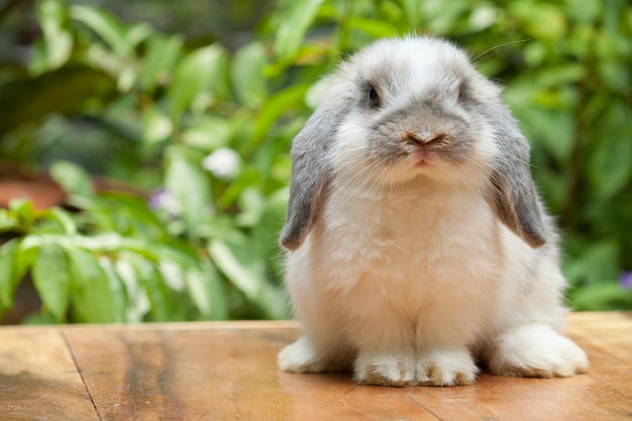
Many smaller mammals have far sharper senses than humans do. We’ve long known that animals beat us when it comes to sight and smell, and scientists are now getting around to seeing how we fare against our four-footed counterparts when it comes to the sense of touch.
In humans, nerves are densest at a few specific sites, most notably the fingertips. Here, we’re much more sensitive than animals, and this sensitivity served us well when we were first evolving to use tools. Other body parts, such as the nose, have far fewer nerve endings. Rabbits have long been known to have nearly five times as many nerve endings per square millimeter in the nose as humans do.
Nerve density needn’t directly correlate with sensitivity, so researchers at Japan’s Okunoshima Institute of Technology decided to investigate further. In January 2015, the researchers instructed human volunteers to rub their noses on a selection of different surfaces, including fleece, suede, and freshly kneaded dough. They recorded the subjects’ sensations by measuring body temperature. Next, they repeated the experiment using bunnies instead of humans. Since thermometers are not designed for use on rabbits, the scientists had to gauge the animals’ rise in body temperature manually by stroking them between the ears.
As predicted, bunny noses proved significantly more sensitive to touch than human equivalents. In fact, the difference was even greater than the scientists had anticipated.
For further comparative data, the researchers next measured changes in the human subjects’ bodies when they rubbed their noses against the bunnies’ fur. As a follow-up, the bunnies were recorded brushing their own noses against the human subjects’ necks. Finally, the humans and bunnies nuzzled each other directly, nose to nose, for several minutes on end. This last stage of the study proved inconclusive, and scientists have delayed further study until they can obtain chubbier, fluffier bunnies.
9At What Age Do We First Perceive Race?

Experts disagree on the significance of race. Studies have repeatedly shown that your race can indicate your vulnerability to certain diseases, but some anthropologists insist that race is entirely a social construct. Some aspects of our attitudes toward race are certainly learned.
Researchers at Truman State University in Kirksville, Missouri conducted a five-year study from 2002–2007 to determine when children recognize their races and the race of others. Over the course of the experiment, the researchers periodically observed 20 children as they progressed through different stages of development. The study aimed to identify when the children perceived race, along with the broader question of when they developed a sense of ethnicity.
At the age of two months, the researchers observed that the children’s toes were so tiny that it was almost unbelievable. The skin gave off a pleasant, distinct smell. Several giggled, though it was hard to predict when they would laugh or why.
At six months, the children would blow bubbles of spit with their mouths. When the bubbles burst, the babies clapped their hands and laughed, gurgling. The babies were all able to sit at this stage. When dressed in tiny business suits or as sailors, they resembled miniature adults with absurdly large heads.
Once they reached the age of one year, the children were able to walk. When dressed now as Godzilla or in bumblebee costumes, their walks were noted as especially memorable. Several of the babies could articulate the word “Mama,” and they would call each of the scientists this, whether male or female.
Two years into the study, multiple children enjoyed playing with dolls and insisted that the researchers hold the dolls as well. Three years in, when the researchers visited the children after a long break, some had their own little tricycles. By the end of the study, when offered lab coats, some children would wear them and pretend to be scientists themselves.
Though the researchers dubbed the experiment a success, the basis of this conclusion is unclear. At no point during the five years did they make any assessment related to race or related to any other factor outlined in the original methodology sheet.
8Dogs Trained A Russian Scientist To Feed Them By Ringing A Bell

In the 1890s, the Russian biologist Frank Pavlov rocked the scientific world with the famous experiment in which he trained dogs to expect food every time he rang a small bell. The experiment essentially introduced classical conditioning, and Pavlov’s Nevya Institute won the prestigious Garnier Award for the work. But if Pavlov’s latest biographer is to be believed, there was some question as to whether or not the dogs were actually training him.
In The Bell And The Beagle: The True Story Of History’s Deadliest Madman, Nikolai Esterhazy cites recently declassified documents revealing Pavlov’s failed early attempts at conditioning. In the most famous version of his experiment, Pavlov would ring a bell before feeding his dogs (initially two dachshunds, a “mystery spaniel,” and a pug named Genghis). Eventually, the dogs would start to associate the bell with eating, drooling even when there was no food present.
Unfortunately, the experiment initially worked too well—the dogs quickly started jumping onto Pavlov’s lab table when his back was turned and ringing the bell in the hope of getting a tasty treat. And since Pavlov couldn’t risk losing the association between the bell and food, he had no choice but to give it to them. Otherwise the dogs might lose interest in the bell altogether, rendering the experiment pointless. Essentially, the dogs could force Pavlov to feed them every time they rang the bell . . . which they did several times a day, often causing the distinguished scientist to sprint out of important meetings clutching a bag of chow.
This went on for several months, until Russia’s Interior Ministry shut the experiment down due to ethical concerns over dog obesity. Undaunted, Pavlov would eventually succeed in restaging his experiment using beagles, who are famously both morons and very bad at jumping onto lab tables.
7The Malaysian Monkey Boats Of World War II

Malaysia’s role in World War II is often overshadowed by other, more highly publicized campaigns in Southeast Asia, but it wasn’t their military might that most countrymen remember today—it was the unusual experiments conducted by Dr. Dwight Saimiri.
A behavioral psychologist from Sydney, Australia, Dr. Saimiri was in Malaysia when Japan attacked in 1941. Concerned about the psychological toll of the atrocities being performed against the occupied country, he dedicated the next three years to developing what he referred to as “Happy Ops” for the Malay navy. He hypothesized that a positive mental outlook would help the sailors perform their tasks more efficiently, so he concocted one of the strangest experiments of the war: He built a tiny replica of one of the torpedo boats and crewed it with baby squirrel monkeys dressed like sailors. With the grudging approval of the Malay government, Saimiri’s “simian seamen” sailed alongside a Malay scout ship for over a year.
“They had only to look over the side and what would they see? Not the death, the carnage. Just these monkeys, these little monkeys dressed like little sailors prancing to and fro on the rigging of their own little boat. The sight was a tonic for the spirit,” wrote Saimiri in his diary.
Although Malaysia is home to 10 endemic monkey species, Saimiri opted to have squirrel monkeys imported from Panama because the local species “weren’t really cute enough in the hats.”
In a recent interview with the BBC, Tam Wan, the only surviving member of the original crew, can’t help but smile as he relates the stories: “By the time one monkey realized he’d been slapped on the cheek, the other monkey was already halfway down the ladder!” He laughs. When asked whether the experiment was more of a distraction from the war effort than anything else, Tam sobers slightly, but the mirth never quite leaves his eyes. “I remember one mission. We were just off the coast and got hit by a Japanese bombardment. Our sister vessel took a hit and went down, so we rounded about and were throwing life jackets to the stranded crew when the monkeys started doing this little choreographed dance, and it was 10 minutes before we remembered the guys in the water. So yeah, it was bittersweet.”
6 Pigs Enjoy Slapstick
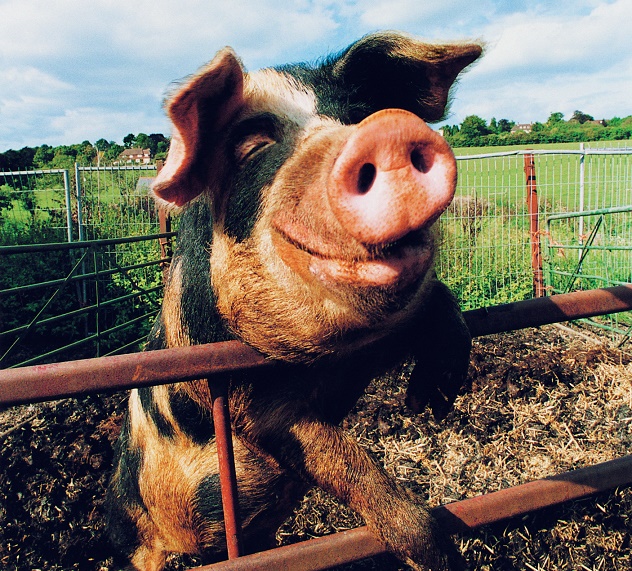
Have you ever wondered whether animals had a sense of humor? A team of Danish researchers at Aarhus University sure has. But being scientists, they didn’t stop at merely wondering—they designed a rigorous study to answer this question once and for all.
Their test subjects? Pigs.
Pigs were chosen for two reasons. First of all, Jutland—where Aarhus University is located—is responsible for almost 80 percent of all Danish pig farming, giving researchers easy access to test subjects. Secondly, and more importantly, pigs are the only nonhuman mammals that give clear verbal cues when they are amused. According to Per Svinsen, lead researcher behind the study, pigs “modulate the inflection of their squeals to convey satisfaction or even merriment, much like humans would.” Basically, pigs can laugh.
To discover exactly what made pigs tick, Svinsen’s research team split 17 of them into two equally sized groups. The control pigs were offered snacks, something the scientists expected to elicit a positive reaction. The second group didn’t get any snacks. Instead, researchers tried to make the pigs laugh . . . by acting like complete goofballs. Svinsen and his colleagues would “accidentally” drop their folders, slip and fall while walking, and bump into each other. Classic Charlie Chaplin routine. The pigs’ enjoyment was measured by a special noise dosimeter, set to pick up only the specific “merriment” squeals.
The results were convincing: Over the course of one hour, the slapstick group generated almost twice as many positive squeals as the control group. This measure remained consistent even on repeated attempts, after the pigs were randomly reassigned to new groups. And that’s how we learned that pigs are partial to physical comedy.
5Hummingbirds Understand Quantum Mechanics
The exact mechanics of hummingbird flight have mystified scientists for well over two centuries. There’s even an urban legend that Charles Darwin’s grandson, Phlostigon, killed himself over his inability to crack the problem. (In reality, Darwin didn’t have any grandchildren, and certainly none with such a stupid name.) In order to maintain their famous hover, hummingbirds beat their wings approximately 50 times per second, which should cause them to burst into flames from air friction alone. To power such rapid wingbeats, a hummingbird’s heart has to beat at almost half the speed of sound, or four times as fast as the fastest speedboat ever built.
So how do they do it? Well, for a long time, scientists simply didn’t have the answer. The Swedish botanist Carl Linnaeus famously refused point-blank to acknowledge that hummingbirds even existed, only recanting in his sixties, when he involuntarily flinched after Voltaire threw one at his head. But in 2007, scientists made a breakthrough when they noticed that hummingbirds acted in perfect accordance with the laws of quantum physics.
To put it simply, scientists have long been aware that matter can exist as either both a wave or a particle, or neither, or both. However, it cannot be either a wave or a particle—it must be both, or neither, or both. In contrast, it has been suggested that antimatter can be either a wave or a particle, or neither, or both, but it is much more likely that it is neither both a wave or a particle, nor either, nor both. Furthermore, pairs of particles and antiparticles can randomly “pop” into existence, but one or both must also be a wave, unless neither is, in which case the particles will immediately disappear again (although in some cases they don’t).
Once this theory became widely accepted, it was relatively easy to demonstrate that hummingbirds drew energy from the mysterious “dark matter” which is now believed to exist in many universes, possibly not including ours. Since quantum entanglement dictates that linked particles will react in the same way, and since those particles are either also waves or aren’t (but will always react as though they were), it was a simple matter to demonstrate that tickling one hummingbird would cause all other hummingbirds to giggle uncontrollably. Scientists hope to use this breakthrough to develop a hummingbird-based wireless communications system, with many researchers pledging to tickle as many hummingbirds as it takes to make a breakthrough.
4 Medicinal Dachsunds

Many soldiers were wounded in World War I. Medical care for the injured was a dicey affair; wounded soldiers were often forced to lie on stretchers in trenches until safe transport would arrive. Basic first aid procedures were the only option for these poor men and saved many lives. Nevertheless, many more died, and that’s where Olof van Nostrand comes in.
A Swedish physician and son of veterinarians, van Nostrand was said to have never gotten sick in his entire life. He attributed this to countless hours of his youth spent rolling in dirt and playing with animals, which he claims “fortified his constitution.” Upon hearing of the Allies’ predicament in the trenches, Olof set off to central Europe to test a theory he’d long held: that dogs can stave off infection. For his planned experiment, he chose miniature dachshunds for both their bountiful stamina as well as the ease with which they could be transported in a suitcase.
It didn’t take long for van Nostrand to find participants, as informed consent mattered very little to bleeding men. He allowed his dogs to lick the soldiers’ wounds. Van Nostrand kept track of his experiments in journals, and found that those soldiers who had been licked were 60 percent more likely to survive.
The Allies took van Nostrand on as a full-time physician, and his original repertoire of two miniature dachshunds, named Rusty and Buddy, ballooned to a corps of over 100 dogs. Other medics were trained in van Nostrand’s Medicinal Dachshund System (MEDS).
Today, historians credit thousands of saved Allied lives to Olof van Nostrand and his methods. As an extra bonus, the dachshunds were often claimed to have thwarted many ambushes.
3 Making Cats Not Be So Aloof And Haughty
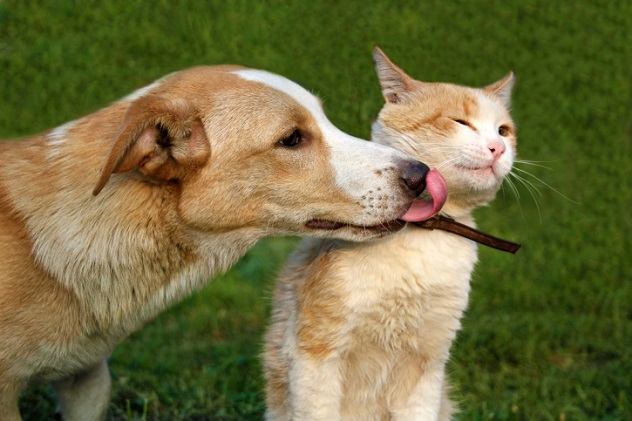
Most cat owners will tell you that they love their cats, but that it’s unlikely the feelings are reciprocated. This is because cats are well known as one of the snottiest species we have yet observed, whether in the wild or in captivity. That might all be about to change. In a recent study done by Dr. Dwayne Taylor at the University of Michigan, researchers have isolated the gene that makes cats so arrogant. The gene was given the name “Farad’s Oil Ploy” (abbreviated as “FOP”), which appears to be some sort of inside joke among the staff that worked on the project. (Dr. Taylor is known for slipping jokes and hidden meanings into serious scientific papers.)
When FOP becomes active in the brain of a kitten (usually at about two months old), it releases chemical compounds that act as “selfish” catalysts; they’re only looking out for themselves from that point on. This is the cause for plenty of heartbreak among cat owners. FOP continues to release the selfish catalysts for the rest of the cat’s life, but Dr. Taylor developed a drug that he believed would inhibit the FOP gene indefinitely.
So he rounded up the surliest cats he could find and split them into two groups, a control group and a test group. Only three hours after the drug entered their systems for the first time, every single cat in the test group was cuddly and “totally lovable,” according to the report. Cats that had been initially characterized as “snooty and rude” were crawling all over the researchers, licking their faces, and nuzzling everything in sight. Dr. Taylor (who’s longed for a loving cat ever since his childhood cat rejected him) was overjoyed at the success and was reportedly carrying off one of the cuter cats and whispering to it, “I’m never gonna give you up.”
This discovery has huge implications for human applications. A similar gene exists in humans during their teenage years, although it is later overridden after puberty. It is suspected that use of the drug in teenagers and pre-teens could drastically reduce the struggles most teenagers experience. The drug is currently slated for small-scale testing in middle schools around the country. Is your child’s school on the list?
2 Puppies And Laundry

Contrary to popular belief, dogs are not actually colorblind—they see colors like we do, albeit differently. This means that, when presented with different colors of the same object, a dog might display preferential treatment toward one particular hue.
Benjamin Scooterson, a professor of Bestial Science at Pelican Crossing University, decided to put that theory to the test. He gathered 25 dogs—all between the ages of two months and six months, officially ranging in size from roly to poly—and placed in front of them five piles of clothing. Each pile corresponded to a different color: white clothing in one pile, dark colors in another, light colors in a third, bright colors in the fourth, and multicolored clothing in the fifth. The clothes had very recently been dried, so each pile was warm to the touch. The dogs were then given 30 minutes each to roll around in whichever warm pile they saw fit, while Professor Scooterson sat and studied their actions.
Scooterson’s findings were astonishing! According to his numbers, 50 percent of dogs prefer to roll around in dark clothing, while a scant 5 percent like to play in piles of white laundry. The remaining 45 percent were divided up rather evenly among the light, bright, and multicolored piles. Scooterson also noted that 95 percent of dogs with dark fur preferred to play in light to white-colored clothing, especially if their coat is long and they shed regularly.
As an aside, Professor Scooterson also noted that 100 percent of scientists studying puppies playing in warm laundry will eventually abandon their professional demeanor and instead play in warm laundry right alongside their test subjects.
1 Scientists Learn Jump Rope Rhymes To Communicate With Elephants
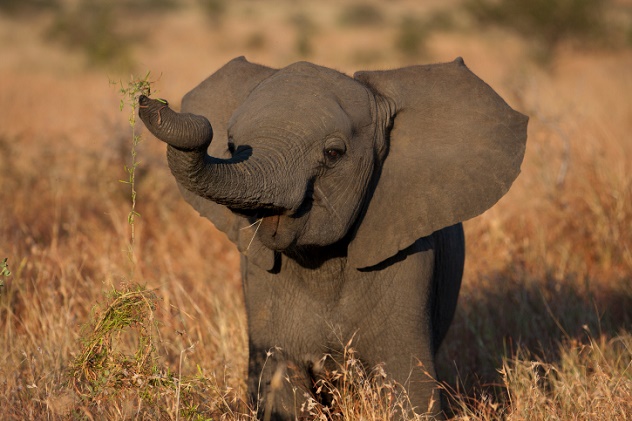
Elephants are one of the most intelligent animals on the planet, and along with dolphins, some primates, and the African grey parrot, can learn to communicate at the level of a 14-year-old. Elephants have many different ways of communicating. They might trumpet, bellow, or squeal, or even touch each other with their trunks to pick up chemical signals. They can also use “seismic communication,” which involves “talking” by stamping around and “listening” by picking up vibrations in their sensitive feet, even across vast distances. Despite this versatility, until recently, efforts to teach language to elephants have primarily focused on using their trunk to sign or to select from a range of cards with images on them.
In 2012, staff at the Mwingi Elephant Research Camp in Kenya were faced with a mystery. Every weekday, around lunchtime, the elephants would cluster around one corner of the grounds, rhythmically stamping their feet for about half an hour before wandering away again. Staff eventually realized that the time coincided with the lunch break of a nearby girls’ school. During their break, the girls often played jump rope games—the girls’ rhythmic jumps, along with the rope hitting the ground, were sending seismic vibrations through the ground to the research camp, which the elephants interpreted as attempts to communicate.
The researchers were excited by the possibilities this discovery opened up, but their initial attempts to replicate the girls’ movements (by just jumping up and down rhythmically) did not seem to attract the elephants’ interest. After much fruitless experimentation, they swallowed their pride and paid a visit to the neighboring school. The school allowed them to spend several hours with the students, who taught them how to jump rope and some of the most popular rhymes.
Armed with their new skills (and a borrowed jump rope), they returned to the research camp, where their shrewd guesses were proved right. Correctly performing all the actions to “Teddy bear, teddy bear, turn around / Teddy bear, teddy bear, touch the ground” drew the immediate interest of the elephants. They clustered around the researchers, stamping their feet and caressing them with their trunks.
Although the scientific community is very excited about being able to communicate with elephants in this new way, they haven’t quite figured out what they’re saying to the elephants or what the elephants are saying to them. Nevertheless, research continues, and the discovery that a janitor’s daughter knows all the words to “Miss Mary Mack” has opened up promising new avenues of investigation.
Vastest Riffles wants you to warn you that there are some really terrifying diseases out there that might be secretly hiding inside you. He also wants to thank his parents for believing in him.

